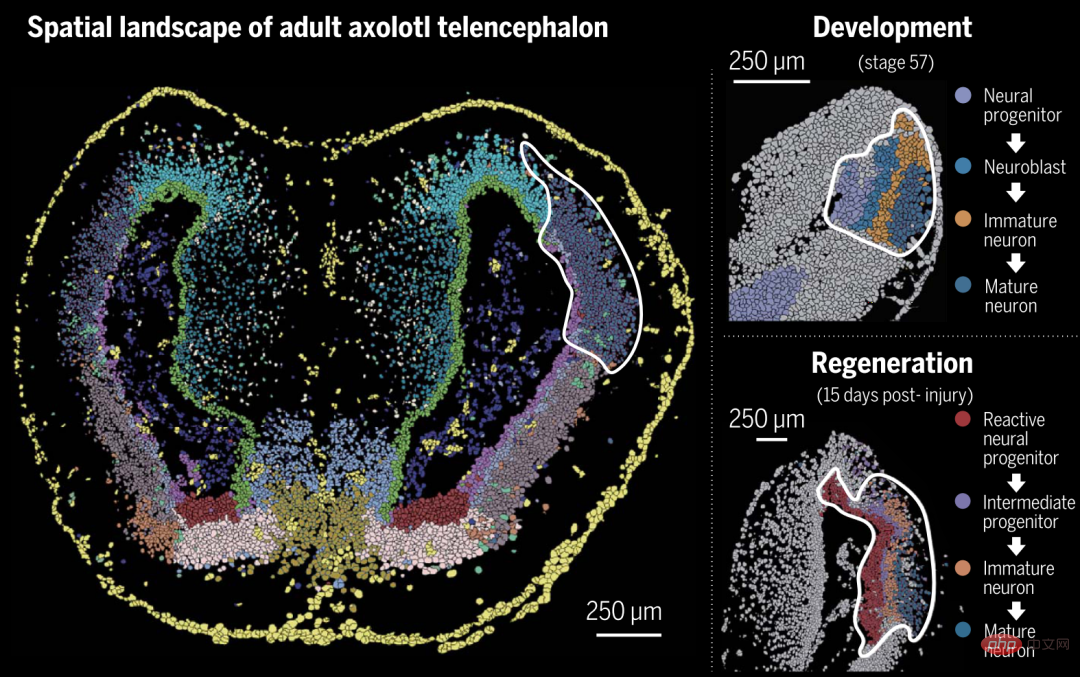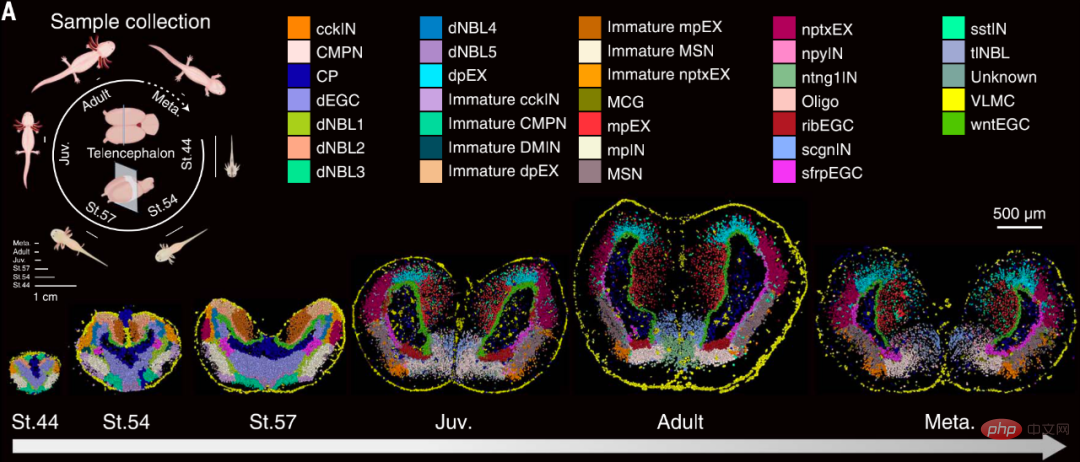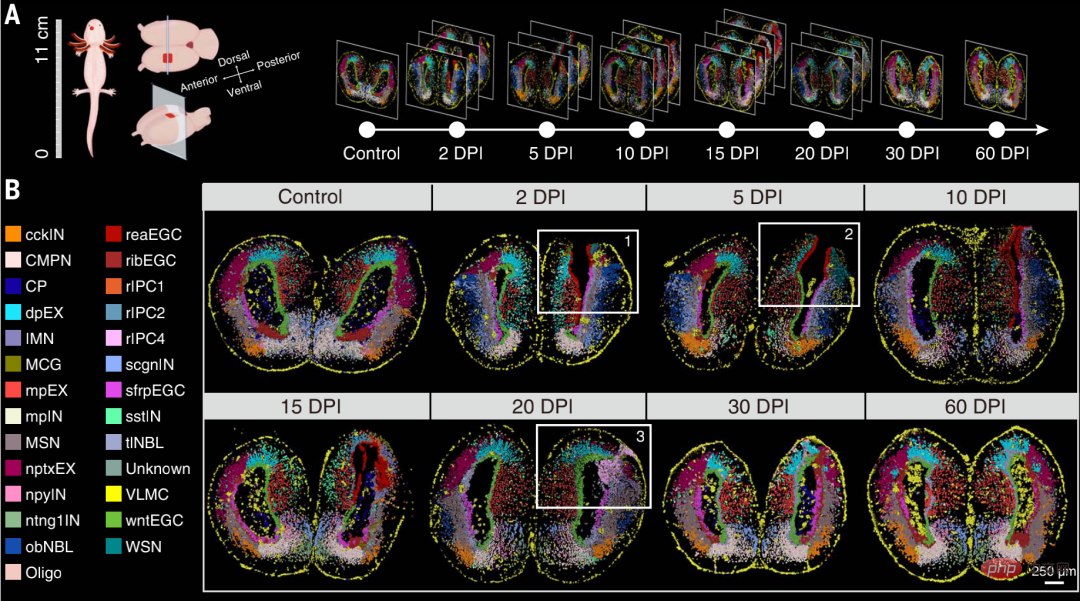 Technology peripherals
Technology peripherals
 AI
AI
 Science's big cover: Chinese team releases the world's first brain regeneration map!
Science's big cover: Chinese team releases the world's first brain regeneration map!
Science's big cover: Chinese team releases the world's first brain regeneration map!
Is it true that the human brain can only develop 10%?
#In the movie "Super Body", the heroine Lucy develops 100% of her brain potential by accident.

With the rapid evolution of her body, she has mastered more and more superpowers: mastering foreign languages instantly, using Brain waves can move objects through space and change the shape of objects at will...
If you want your brain's neurons to continue to develop One possibility is that our brain cells have the ability to regenerate.
#Currently, the only creature in the world that can regenerate its brain is the silly and cute "mythical beast" the salamander.

#But, can humans achieve brain regeneration?
#Recently, a team led by the BGI Life Sciences Institute completed the first spatiotemporal map of salamander brain regeneration, revealing how brain damage heals itself.
# This is the world’s first space-time map of brain regeneration, and the research results were published on the cover of Science on September 2.

The first space-time map of brain regeneration
When it comes to regeneration ability, lizards can no longer regenerate their tails. strange.
In addition, bat wings, zebrafish hearts, shark teeth, starfish limbs... can all be regenerated.
# Only the ability of biological "brains" to regenerate fascinates scientists.
This articleSingle-cell Stereo-seq reveals induced progenitor cells involved in axolotl brain regeneration introduces us to axolotl brain regeneration Space-time map.

Paper address: https://www.science.org/doi/10.1126/science.abp9444
#To study brain regeneration, we must find a suitable model to conduct research.
#In the end, the research team chose the only creature in the world that can regenerate its brain - the Mexican axolotl.
It is a type of salamander, also known as the "Hexagonal Dinosaur". In addition to being able to regenerate limbs, tails, eyes, skin, liver and other organs In addition, the brain can also regenerate.

##Development and regeneration of the telencephalon of the salamander
Couldn’t this be used by scientists as an important model organism to study problems related to regeneration?
Here we have to mention the key technology of this research - spatiotemporal omics technology (Stereo-seq).
With this technology, scientists can take photos that can clearly see the changing status of cell molecules during the six important periods of axolotl brain development. A spatial and temporal map of brain development in salamanders.

#Brain regeneration requires the coordination of complex responses in a time- and region-specific manner. Identifying the cell types and molecules involved in this process will advance scientists' understanding of brain regeneration.
# However, progress in this field has been hampered by the limited regenerative capacity of the mammalian brain and the incomplete mechanistic understanding of the regenerative process at the cellular and molecular levels. be hindered. The aforementioned Mexican axolotl can regenerate damaged appendages and multiple internal organs, including the brain.
# Therefore, this salamander has become an ideal model for scientists to study brain regeneration. To understand the mechanisms of brain regeneration, scientists also need research tools that enable large-scale data collection and analysis to simultaneously decode complex cellular and molecular responses.
#First of all, scientists believe that if brain regeneration and development processes are compared in the study, it will help provide a new understanding of the nature of brain regeneration.
#So the research team removed a small portion of the lateral palate region of the left telencephalon of axonids and collected tissue samples from multiple stages of the regeneration process. Tissue samples from the axozoan telencephalon at multiple stages of development were then collected.
#The researchers then used high-definition and large-field Stereo-seq technology to generate single slices from slices covering both hemispheres of the telencephalon Spatial transcriptomic data at cellular resolution. Cell type annotation, cell spatial organization, gene activity dynamics, and cell state transitions were analyzed, and mechanistic studies of damage-induced regeneration compared to these cellular properties during development were performed. Using Stereo-seq, the scientists generated spatial transcriptomic data for a set of telencephalon slices covering six developmental stages and seven damage-induced regeneration stages of the axolotl.

Single-cell resolution data allowed researchers to identify 33 cell types present during development and involved in regeneration of 28 cell types, including different types of excitatory and inhibitory neurons, as well as several ectodermal cell subtypes.
Developmentally, the data reveal a primitive type of epithelium that may give rise to three subpopulations of adult epithelial cells that are distributed in the ventricular zone Different regions have different molecular characteristics and potential functions.
#In terms of regeneration, the research team discovered a subpopulation of epithelial cells that may originate from local resident epithelial cells activated by injury. This population of cells may then proliferate to cover the wound area, subsequently replenishing lost neurons through state transitions to intermediate progenitors, immature neurons, and ultimately mature neurons.
When comparing the cellular and molecular dynamics of the axonal animal telencephalon between development and regeneration, scientists discovered that damage-induced epithelial cells have significant changes in their transcriptomic states. Aspects are similar to developmental stage-specific epithelial cells.
#At the same time, the research team also observed that the regeneration of the axonal telencephalon behaves similarly to that in development in terms of molecular cascades and potential cell line switching. patterns of neurogenesis, suggesting that brain regeneration partially recapitulates developmental processes. Spatial transcriptomic data highlight cellular and molecular features of the axonal telencephalon during development and injury-induced regeneration. Further characterization of the activation and functional regulation of epithelial cells may yield insights into improving the regenerative capacity of the mammalian brain.
The research team's study of the single-cell spatial transcriptome of the tetrapod telencephalon provides useful information for further research on developmental, regenerative and evolutionary brain biology. The data.
Is brain regeneration a reality?
You must know that the human brain has 86 billion neurons, which are connected to each other.
Dr. Yin Gu, joint corresponding author of the paper and deputy director of BGI-Research, said,
Using the axolotl as a model organism, we have identified key cell types during brain regeneration. This discovery will provide new ideas and guidance for regenerative medicine of the mammalian nervous system.

Therefore, a major goal of regenerative medicine in the central nervous system is to reconstruct not only the spatial structure of neurons but also the specific patterns of connections within their tissues .
#In future studies, it will be important to reconstruct the 3D structure of the brain and understand the systematic response of various brain regions during the regeneration process.
Scientists have long dreamed of understanding how the nervous system works by mapping the structure of the entire brain's neural network.
For example, Google reconstructed the 3D model of Drosophila brain neurons for the first time in 2019, and then announced the Drosophila "half-brain" the following year. Connection group.
#Now, they have released a human brain imaging data set.

Through this data set, people can see 130 million synapses and tens of thousands of neuron samples , can help people understand the 3D structure of the brain.
In addition to axolotls, scientists have used spatiotemporal omics technology to map the embryos of four model organisms: mouse, zebrafish, fruit fly, and Arabidopsis for the first time. Spatiotemporal maps of development or organs.
#Currently, the research results have been published in Cell and its sub-journal Developmental Cell.

Regarding the research on brain regeneration, netizens are optimistic about its future development.


The above is the detailed content of Science's big cover: Chinese team releases the world's first brain regeneration map!. For more information, please follow other related articles on the PHP Chinese website!

Hot AI Tools

Undresser.AI Undress
AI-powered app for creating realistic nude photos

AI Clothes Remover
Online AI tool for removing clothes from photos.

Undress AI Tool
Undress images for free

Clothoff.io
AI clothes remover

Video Face Swap
Swap faces in any video effortlessly with our completely free AI face swap tool!

Hot Article

Hot Tools

Notepad++7.3.1
Easy-to-use and free code editor

SublimeText3 Chinese version
Chinese version, very easy to use

Zend Studio 13.0.1
Powerful PHP integrated development environment

Dreamweaver CS6
Visual web development tools

SublimeText3 Mac version
God-level code editing software (SublimeText3)

Hot Topics
 1386
1386
 52
52
 Four recommended AI-assisted programming tools
Apr 22, 2024 pm 05:34 PM
Four recommended AI-assisted programming tools
Apr 22, 2024 pm 05:34 PM
This AI-assisted programming tool has unearthed a large number of useful AI-assisted programming tools in this stage of rapid AI development. AI-assisted programming tools can improve development efficiency, improve code quality, and reduce bug rates. They are important assistants in the modern software development process. Today Dayao will share with you 4 AI-assisted programming tools (and all support C# language). I hope it will be helpful to everyone. https://github.com/YSGStudyHards/DotNetGuide1.GitHubCopilotGitHubCopilot is an AI coding assistant that helps you write code faster and with less effort, so you can focus more on problem solving and collaboration. Git
 Which AI programmer is the best? Explore the potential of Devin, Tongyi Lingma and SWE-agent
Apr 07, 2024 am 09:10 AM
Which AI programmer is the best? Explore the potential of Devin, Tongyi Lingma and SWE-agent
Apr 07, 2024 am 09:10 AM
On March 3, 2022, less than a month after the birth of the world's first AI programmer Devin, the NLP team of Princeton University developed an open source AI programmer SWE-agent. It leverages the GPT-4 model to automatically resolve issues in GitHub repositories. SWE-agent's performance on the SWE-bench test set is similar to Devin, taking an average of 93 seconds and solving 12.29% of the problems. By interacting with a dedicated terminal, SWE-agent can open and search file contents, use automatic syntax checking, edit specific lines, and write and execute tests. (Note: The above content is a slight adjustment of the original content, but the key information in the original text is retained and does not exceed the specified word limit.) SWE-A
 Summary of the five most popular Go language libraries: essential tools for development
Feb 22, 2024 pm 02:33 PM
Summary of the five most popular Go language libraries: essential tools for development
Feb 22, 2024 pm 02:33 PM
Summary of the five most popular Go language libraries: essential tools for development, requiring specific code examples. Since its birth, the Go language has received widespread attention and application. As an emerging efficient and concise programming language, Go's rapid development is inseparable from the support of rich open source libraries. This article will introduce the five most popular Go language libraries. These libraries play a vital role in Go development and provide developers with powerful functions and a convenient development experience. At the same time, in order to better understand the uses and functions of these libraries, we will explain them with specific code examples.
 Learn how to develop mobile applications using Go language
Mar 28, 2024 pm 10:00 PM
Learn how to develop mobile applications using Go language
Mar 28, 2024 pm 10:00 PM
Go language development mobile application tutorial As the mobile application market continues to boom, more and more developers are beginning to explore how to use Go language to develop mobile applications. As a simple and efficient programming language, Go language has also shown strong potential in mobile application development. This article will introduce in detail how to use Go language to develop mobile applications, and attach specific code examples to help readers get started quickly and start developing their own mobile applications. 1. Preparation Before starting, we need to prepare the development environment and tools. head
 Which Linux distribution is best for Android development?
Mar 14, 2024 pm 12:30 PM
Which Linux distribution is best for Android development?
Mar 14, 2024 pm 12:30 PM
Android development is a busy and exciting job, and choosing a suitable Linux distribution for development is particularly important. Among the many Linux distributions, which one is most suitable for Android development? This article will explore this issue from several aspects and give specific code examples. First, let’s take a look at several currently popular Linux distributions: Ubuntu, Fedora, Debian, CentOS, etc. They all have their own advantages and characteristics.
 Exploring Go language front-end technology: a new vision for front-end development
Mar 28, 2024 pm 01:06 PM
Exploring Go language front-end technology: a new vision for front-end development
Mar 28, 2024 pm 01:06 PM
As a fast and efficient programming language, Go language is widely popular in the field of back-end development. However, few people associate Go language with front-end development. In fact, using Go language for front-end development can not only improve efficiency, but also bring new horizons to developers. This article will explore the possibility of using the Go language for front-end development and provide specific code examples to help readers better understand this area. In traditional front-end development, JavaScript, HTML, and CSS are often used to build user interfaces
 Understanding VSCode: What is this tool used for?
Mar 25, 2024 pm 03:06 PM
Understanding VSCode: What is this tool used for?
Mar 25, 2024 pm 03:06 PM
"Understanding VSCode: What is this tool used for?" 》As a programmer, whether you are a beginner or an experienced developer, you cannot do without the use of code editing tools. Among many editing tools, Visual Studio Code (VSCode for short) is very popular among developers as an open source, lightweight, and powerful code editor. So, what exactly is VSCode used for? This article will delve into the functions and uses of VSCode and provide specific code examples to help readers
 Is PHP front-end or back-end in web development?
Mar 24, 2024 pm 02:18 PM
Is PHP front-end or back-end in web development?
Mar 24, 2024 pm 02:18 PM
PHP belongs to the backend in web development. PHP is a server-side scripting language, mainly used to process server-side logic and generate dynamic web content. Compared with front-end technology, PHP is more used for back-end operations such as interacting with databases, processing user requests, and generating page content. Next, specific code examples will be used to illustrate the application of PHP in back-end development. First, let's look at a simple PHP code example for connecting to a database and querying data:




